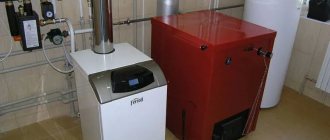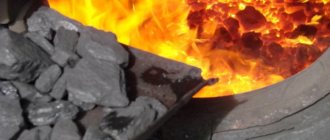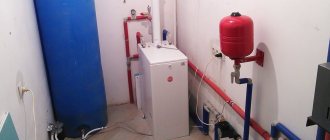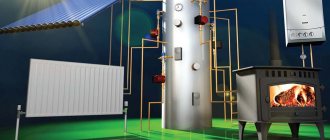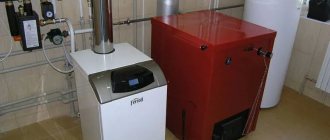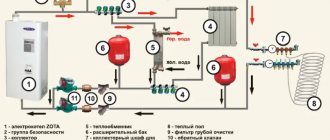Some Russians heat their homes with units that consume diesel fuel. Many people, when buying a diesel boiler, calculate fuel consumption per day or per year themselves. Without knowing the operating features of such equipment, most people make mistakes and purchase a unit of the wrong power. To carry out the calculations correctly, you need to take into account all the nuances and imagine how you can save the fuel you use.
Diesel boiler is an autonomous heating equipment.
Diesel boiler and its features
The fuel consumption of diesel fuel equipment is low. In addition, the heat exchanger is heated not only by the flame, but also by combustion products that move through its body before being released outside, which greatly increases the efficiency of the unit. Therefore, diesel heaters are popular in populated areas where there is no gas.
During their operation, odors may be released, which is why it is recommended to install the units in a separate room. If it is not there, you should take care of forced ventilation. In this case, the direction (discharge of harmful substances to the outside or the influx of fresh air from outside) of the chimney does not matter. The main thing is to insert the fan and protect the pipe from moisture.
Diesel equipment is an alternative to gas and solid fuel units if it is properly adjusted and operated correctly. Fuel for it can be kept in a tank located anywhere:
- underground (in the basement, cellar);
- on the street (under a canopy);
- in the boiler room.
This is the main advantage of such devices.
Requirements for a diesel boiler room in the house
Installing a diesel boiler in a house is a complex technical process that requires qualified assistance. When connecting, take into account current regulatory requirements and fire safety rules. Setup and maintenance are carried out using special computer software.
The organization of heating in a private house with a diesel boiler is carried out in compliance with the following conditions:
- The room for the boiler is selected from technical rooms with sufficient area, lighting, and ventilation.
- Placement of diesel boiler houses in residential country houses is carried out on a non-combustible basis. Walls and floors are finished using non-combustible building materials: ceramic tiles, plaster.
- Automation – maintaining the temperature in the house is carried out automatically. Human participation in the operation of the heat generator is reduced to a minimum. It is mandatory to install an automatic safety system that turns off the operation of the boiler in the event of an emergency.
- Ventilation in the boiler room is provided through channels with natural and forced air supply and exhaust. The cross-section of the ventilation duct is calculated based on triple air exchange within an hour.
- Diesel fuel storage is installed in a separate building. In the boiler room, it is allowed to store a reserve tank with a maximum capacity of no more than 3-5 m³.
Correct installation of a diesel boiler in a residential private house is based on an understanding of work processes. The burner device creates strong noise interference, therefore, soundproofing measures are carried out in the boiler room.
Additionally, a UPS and a stabilizer are installed to ensure system operation even during power surges or power outages.
Advantages and disadvantages of household diesel boilers
Reviews of diesel heating boilers for private houses and cottages point to the same problem. The domestic consumer, even if he reads the operating instructions, adjusts the operation of the boiler to his needs, violating the manufacturer’s recommendations, which is the main cause of malfunctions.
The performance of boiler equipment depends on proper operation, from accurately adjusted settings to the need for regular maintenance. If you heat your house correctly with a diesel boiler, high rates of efficiency and heat transfer are observed. Any violations lead to excessive fuel consumption.
The disadvantages of heaters are:
- Noise of boilers - as a rule, the noise is not heard if the passage to the boiler room is closed by a door. It is not recommended to install a diesel boiler in the kitchen or any room adjacent to living rooms.
- Maintenance cost - you will need to regularly clean the heat exchanger and chimney pipe from accumulated soot. When switching to another type of liquid fuel, as well as before the start of the heating season, the burner needs to be adjusted. The optimal solution that allows you to save money is to sign a permanent service agreement.
The advantages of boilers are low installation costs, quick commissioning, and no need to obtain permits or approvals.
The most economical boiler is one that is installed and operated in accordance with the manufacturer's recommendations. After installation and connection, a company representative will provide instructions on how to use the heat generator.
Operating experience shows that following the recommendations is the best way to extend the life of the boiler, ensure maximum heat transfer and comfortable heating of residential premises.
Calculation of power and temperature of a warm water floor
Fuel consumption for different models of diesel boilers
Modern liquid fuel devices consume approximately 1 kg/h per 10 kW of power. Dual-circuit units are also produced, which, when using 1 kg of fuel, in addition to increasing the temperature in the room, heat approximately 5 liters of water to +50...+100°C.
Fuel consumption is 1 kg/h per 10 kW of power.
Comparison of several brands of diesel boilers:
- Korean unit Kiturami TURBO-21 R with a power of 24.4 kW and a fuel consumption of 2.8 kg/h. It not only heats 245 m², but is also capable of dispensing 14 liters of hot water per minute.
- Heater from Korea NAVIEN LST-50KR (50 kW, 5.8 kg/h). Maintains normal temperature over an area of 500 m² and heats up at about 29 l/min.
- Diesel boiler from Germany Buderus Logano G225-78 SE. It does not have a hot water function, but is capable of heating an area of 780 m². At the same time, it uses only 7.2 kg of fuel per hour.
Types of water heating systems
Before installing heating in a private home, in order to avoid installation errors, you need to understand the principle of its operation. It is based on the movement of heated liquid through pipes. Along the way, it gives off heat to the room. The system can be arranged in various configurations. Let us consider in detail the device of each.
Organization of the heating system
Water system “Warm floor”
The installation of a heated floor can be made either as an addition to the radiators or as an independent installation.
Combined floor heating system with radiator
The main advantage of this configuration is the ability to set different temperature conditions for each floor, since cold air rises and warm air remains below.
The temperature in the system can be lowered to +55°C, which is recommended by design standards. Pipe distribution is arranged over the entire floor area, this is effective for uniform heating of the room.
The main disadvantages of heated floors include:
- complexity of installation;
- Possibility of installation only at the construction stage;
- difficulty during repairs.
Connecting heated floor heating
Baseboard heating systems
They perfectly replace conventional radiators and underfloor heating systems. The pipes are installed at the level of the baseboards, and the room is heated sequentially. Manufacturers offer a variety of shades of pipes for installation “under the baseboard”; you can choose the color to match the interior or diversify it.
Installation of baseboard systemwarm water baseboard
Radiator
Radiators are a more familiar system. Manufacturers produce interesting models both in configuration and in cost. You can choose a completely budget product. Currently, radiators are made from:
- cast iron:
- become;
- aluminum
Aluminum radiator in the interior
Heating system of a one-story house with natural circulation
Natural coolant circulation is possible only in one-story houses. A liquid in a hot and cooled state has different densities. At their difference, flows move. The warm coolant rises, the cooled coolant flows down. The flow movement is continuous.
The main advantage of the system is simple and affordable installation. In addition, the heating system can operate without a pump, which significantly saves money.
The disadvantages include installation of pipes at a certain slope. It is necessary to strictly adhere to the calculated parameters during installation. In addition, it is necessary to install an expansion tank in the attic or roof.
Comparison of systems with natural and artificial circulation
Systems with forced circulation of coolant
Forced transfer of coolant occurs thanks to pumping equipment. This is a more efficient system, thanks to which the heated liquid reaches the most remote points
This is important for 2-storey houses. The efficiency of such a system is one third higher than natural
The advantages include the installation of a pipe system without a slope, which greatly simplifies installation. Expansion tanks are also not installed. Instead, pumped storage tanks are used.
Negative features of the system include the need to install fittings on pipes. It acts to protect against emergency situations associated with increased coolant pressure. In addition, it is necessary to install safety valves on both sides of the circulation pump equipment.
Pump connection diagram
What determines fuel consumption?
Some people complain that, despite assurances about the low fuel consumption of diesel equipment, the diesel fuel in their boiler tank quickly runs out and requires frequent refilling.
This may happen:
- due to incorrectly selected equipment:
- in case of breakdown;
- for other reasons.
If a unit of the wrong power is purchased, then it will take more time to warm up the room, which will lead to increased fuel consumption. For example, heating a house of 300 m² with a 20 kW boiler will require 1.5-2 times more fuel than when operating a 30 kW unit.
Fuel consumption increases due to incorrectly selected equipment.
Hardware faults are as follows:
- equipment is not configured;
- burnout or breakage of parts;
- poor pipe insulation.
Complete combustion of fuel and lubricants occurs only when the proportions of air and diesel fuel are correctly set. Incorrect burner adjustment leads to ignition of the fuel-air mixture, and not the substance itself. Due to constant under-burning, there will be an overconsumption of fuel and lubricants.
When a diesel unit is operating, fuel enters the chamber through a nozzle, and air through another channel, and the mixture is ignited. If the settings are not made correctly, the flame temperature will increase and this will lead to burnout of the nozzle.
If you do not take care of the thermal insulation of the fuel supply system in time (for example, when the boiler is outside the house), frostbite will occur in some area.
This will cause the pipes to clog.
Alternatives to gas heating
As I already mentioned, gas heating is the most convenient for permanent residences; gasification of a home is the ultimate dream. However, the total cost of gasifying a home forces us to look for an alternative to gas.
Electricity
Electricity itself is an excellent alternative to gas, if only it weren’t so expensive. Practice shows that over 7 months of the heating season, using only electric heating, you will have to spend 50-60 thousand rubles, and this is with a good setup of the heating boiler.
Using electricity, you can heat your house using:
- Electric heating boiler (100 meters of house = 10 kW boiler).
- Electric convectors (cheap installation, but requires new wiring).
- Film infrared heating (rarely used as the main heating due to the high cost of installation and operation).
In addition to electricity, alternatives to gas can be:
Diesel fuel. There are a lot of disadvantages: expensive equipment, you need a special place for the container, you need to constantly replenish fuel. Cost of diesel fuel: 2-3 rubles per 1 kW of heat.
Firewood. Wood heating is not easy. On the one hand, they are accessible. If you prepare them yourself, they are quite cheap. This is probably why all of rural Finland is heated with wood. In Russia, the cost of purchased firewood is slightly more expensive than gas, but cheaper than all other types of fuel. Gas - 20-30 kopecks per 1 kW, firewood - 70 kopecks, coal 1.3 -1.5 rubles, electricity - 3±1 ruble per 1 kW.
Sun. If you don't live in a sunny area, the sun can be considered a source of heating for your home. Typically, solar collectors can only act as an additional source, for example, of charging the batteries of an uninterruptible power supply system or gas boilers.
BIO fuel. Today, BIO fuel is difficult to consider as a real alternative to other heat sources.
Reasons for increased diesel fuel consumption
For cracks in walls, windows, etc. It will be difficult to heat even a small barn with a powerful boiler. Therefore, before purchasing equipment, make sure your home is well insulated.
Slots in windows can cause increased fuel consumption.
Many consumers forget about basements, garages, and cellars when making calculations. To prevent the cold from coming from there, these rooms also need to be heated. And for this you will need additional fuel. It is necessary to make calculations including all these objects
One of the natural reasons for increased consumption is an increase in the viscosity of fuel and lubricants when the external temperature decreases (for example, if the fuel is stored in a cold room).
During severe frosts, heating the house may require 15-20% more diesel fuel due to its thickening.
What to do in winter?
Everyone knows that the viscosity of diesel fuel, which is used for heating on diesel fuel, increases in winter, and noticeably. Therefore, your pump may not even have enough power characteristics to pump diesel fuel into the boiler room. And if your large tank is located far away, then you should additionally insulate and insulate the fuel wire. Heating a house with diesel fuel should also have a fuel filter, since the quality of diesel fuel can vary. We also note that burying a tank underground entails significant financial expenses.
Thus, heating a private house with diesel fuel is a good comprehensive solution that includes many factors. Undoubtedly, when installing such a system, you must have at least a minimum of knowledge, and ideally, invite a specialist who will help you make high-quality and safe heating of a private house with diesel fuel.
How to calculate diesel fuel consumption by a boiler per day and per month
The average consumption of fuels and lubricants by diesel fuel units is 1 kg/h for every 10 kW. The dependence of the area of the heated room on the power is also approximately 1/10. Using these data, you can calculate the consumption of any amount of fuel per unit time.
Example
Calculation for a house of 150 m²:
- Minimum boiler power: 150/10=15 kW.
- Consumption per hour: 15/10=1.5 kg/h.
- Per day – 24×1.5=36 kg.
You can calculate the fuel consumption per unit time.
The average value of intensive operation of the unit (full load) - end of autumn + winter + beginning of spring is 100 days. To this we must add approximately the same number of days (90-100) of half-loading the boiler for various needs, for example heating water, etc.
Then for a year you will need: 100×36+100×(36/2)=5.2 tons of fuel.
The best manufacturers
Each boiler manufacturer tries to produce a unit with its own burner. Some adapt the boiler to burner devices of other brands.
The most popular diesel burners are: Riello diesel burner, Danfoss modulating burner, Lamborghini diesel burners, Simemack 8 diesel burner, Elco diesel burners, Buderus Logatop DE, Weishaupt, Bentone, De Dietrich M Baltur, FBR and Ferroli.
Buderus Logatop DE 1.2H-0050
A German single-stage diesel fuel burner with fuel preheating is capable of providing a thermal power of 40 kW with an hourly diesel consumption of 6.4 km/h.
The burner is made in a monoblock design and is 100% ready for use. Electrical elements are made in the form of plug-in connections, which ensures quick start-up of the boiler.
The design features a hybrid fan. Flame control is carried out by an ionization electrode. These diesel burners for boilers are equipped with an LCD control display, with the ability to regulate operation, display parameters and a self-diagnosis system. Price: 63,200 rub.
Giersch GU 20 series
Universal burner from the German brand Giersch for two operating modes. It can work on various types of used oils and waste from both industrial and agricultural production.
When changing fuel types, re-equipping the device is not required; this is achieved due to the fact that diesel is atomized under high pressure.
The pump pumps fuel into the burner tank, in which the liquid level is maintained by a float. A heating element is built into the fuel tank to heat the fuel. The heating mode is from 55 to 140 C, which can heat any fuel, even fuel oil, to a liquid state. The burner is equipped with a compressed air supply. Hourly diesel consumption is 2.7 kg/hour. Price: RUB 115,665.
Teplamos ECO 150
The Russian burner device Teplamos ECO 150 operates on a variety of fuels: waste machine oil, stove oil, diesel fuel, fuel oil and agricultural oil waste.
The Teplamos model has the lowest noise parameters. They have a standard size, which ensures their installation on most units. The device operates on compressed air from an external compressor with a thermal power of 150 kW, with an hourly fuel consumption of 11.0 kg/hour. Price: 108,900 rub.
How to save on diesel fuel
Some people choose double-circuit boilers, which have a built-in reservoir for heating water. But such a unit consumes a lot of fuel. To reduce consumption, experts recommend reducing the volume of heated liquid.
In addition, it is undesirable to keep the unit on all the time. It's better to turn it off for half an hour sometimes. Automation will help with this by monitoring the weather and temperature inside the house. The operation of the boiler is controlled by a microprocessor connected to sensors built into the rooms and installed outside.
The controller determines the heating needs of the house and, depending on the outside temperature, sets the optimal burner power.
Such automation will help reduce fuel costs by about 10-15%.
Minimum required power - Specifications
| Diesel heating boiler fuel consumption There is no need to invent anything here and it is better to buy a ready-made container with all the built-in equipment: a float, vapor removal, drain valve, a fuel intake kit, a pipeline for discharging fuel to the burner, etc. In addition to the heaviness, the disadvantage is vulnerability to temperature changes and mechanical stress, simply put, the alloy is quite brittle with the exception of expensive gray cast iron alloys. |
- ambient temperature;
- fuel quality;
- temperature in the room.
DIY burner installation
Installation of the burner should be carried out by experienced professionals, especially if the gas generator and the boiler are under warranty.
However, during operation, situations often arise when operating personnel must install the LTG with their own hands. This process is multi-stage and consists of the following stages:
- installation of control valves on the fuel supply line in front of the burner;
- installation of liquid fuel gas on the front panel of the boiler;
- connecting electrical connectors and ramps;
- installation of a diesel fuel sprayer;
- nozzle installation;
- starting the burner;
- setting up and testing the combustion process with a gas analyzer.
Connection to the power line is carried out according to the electrical diagram specified by the manufacturer in the instructions. When installing fuel lines, their length must be selected in such a way that it is possible to tilt the burner device while servicing the boiler.
Electronic controllers are very susceptible to voltage surges, and therefore it is recommended to connect them to the mains through a stabilizer. In this case, the device will operate for the entire design period and unscheduled repairs of diesel burners will not be required.
